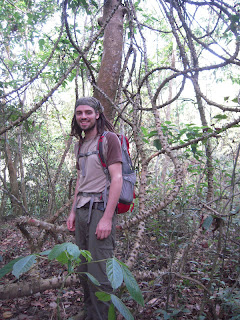We soon left the comforts of Sauraha for a 2-day jungle trek, in Chitwan National Park.
Southern Nepal's Terai region is home to a huge diversity of plant and animal life. In contrast to the frozen mountains of the North, the Terai is very hot and humid year round, giving rise to many tropical species. Nowhere is this ecosystem better displayed than in Chitwan National park, Nepal's oldest park.
Our journey started with an hour long canoe ride down the Rapti river.
With us were our two guides, Tulasi and Somala. They have both been guiding in Chitwan for more than 20 years and they are Tharu people, native to the area.
We saw these crazy red beetles everywhere...apparently they eat the fungus that grows on leaves.
This one is shedding its old exoskeleton.
There were loads of these spiky vines aka lianas, growing among the trees.
A Chelsea-sized termite mound.
Our first rhino encounter! We stopped for lunch at the edge of the pond that this, one-horned white rhino, was cooling off in. Once common throughout the terai, this species is now endangered, due to habitat loss and poaching for their valuable horn, with a population of less 800 individuals.
Somala on the lookout for more rhinos.
Another rhino encounter...while we waited in a tree, Tulasi crept a little closer and started making female rhino noises to try to get this male to come a little closer...a risky business!
These caverns under the tree are the work of different kinds of deer who need to eat clay in order to remove parasites from their gut and to obtain important minerals.
This is lake Lame Tal (pronounced lah-mey not lame).
Some beautiful aquatic plants.
One of the residents of Lame Tal, a Marsh Mugger crocodile.
After a long day, with over 15km of walking we finally reached the small town of Kasara, on the edge of the river, where we stayed for the night.
We had a visitor in our room...one of the biggest spider we'd ever seen, almost the size of a tarantula. Luckily we were safe inside our mosquito net.
Sunrise on the river Rapti.
On the second day we visited a breeding centre for the endangered Gharial crocodile.
This Gharial is over 30 years old.
The locals periodically burn sections of the forest in order to preserve the grasslands and stop the jungle taking over.
These people were gathered at a forest shrine in order to sacrifice goats and ask for blessings from the gods.
We did a lot of walking on the second day...about 30km!
A wildlife viewing platform as seen through some elephant grass, which can reach 3m in height.
A huge fig tree.
As we neared the end of our 2-day trek we were rewarded with our closest wildlife encounter yet. Our guides spot a rhino some ways off and gestured for us to quickly climb a tree, so we could 'get a closer look'.
So we waited in the tree as the rhino wandered closer and closer.
We didn't seem to notice us until he was directly down-wind of us...then he looked directly at us and started to come closer. Needless to say we were getting a little nervous. Our guides soon started making loud intimidating noises and the rhino was soon on his way again.
That night we stayed at a Tharu homestay, in an even smaller village than before.
After some dhal baat and a good night's sleep we were on our way to Pokhara.


















































































